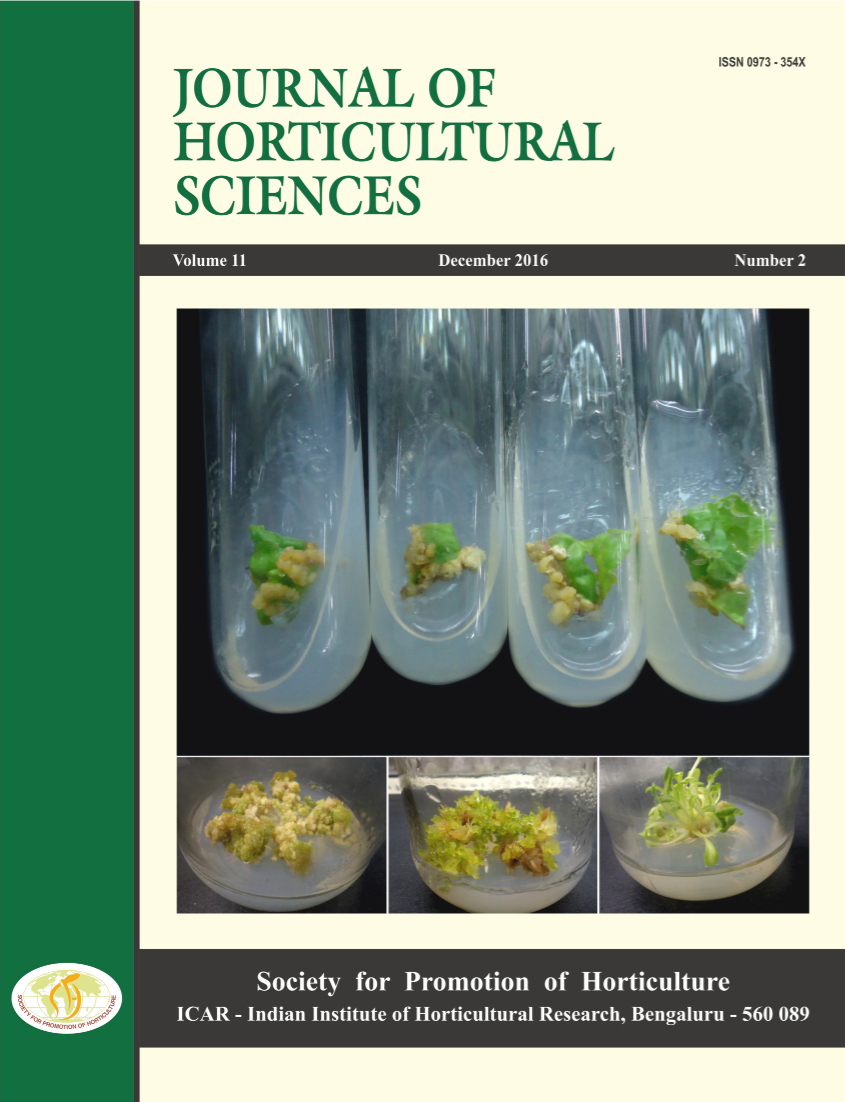PGPR in Managing Root Rot Disease and Enhancing Growth in Mandarin (Citrus reticulata Blanco.) Seedlings
DOI:
https://doi.org/10.24154/jhs.v11i2.80Keywords:
PGPR, Mandarin, Root Rot, Citrus, Bacterial IsolatesAbstract
Decline in general plant-health and fruit production in mandarin influenced by abiotic and biotic factors is a major threat to cultivars grown in Darjeeling and Sikkim hills. Fusarium root rot, caused by F. oxysporum, is one of the most serious diseases afflicted during early plant growth stage in Citrus. To address this, seven PGPR isolates - Pseudomonas poae (RMK03), Bacillus stratosphericus (RHS/CL-01), Ochrobactrum anthropi, Paenibacillus lentimorbus, Bacillus pumilus, Bacillus megaterium and Bacillus amyloliquefaciens were isolated from the rhizosphere of Citrus reticulata, C. limonia and Camellia sinensis, and used for evaluating their effect on growth of mandarin seedlings. Pseudomonas poae showed in vitro antagonism to Fusarium oxysporum. Better growth enhancement was noticed with P. poae, B. stratosphericus, O. anthropi and B. pumilus. Enhanced activity of chlorophyll, total protein, phenol, four major defense enzymeschitinase, β-1, 3-glucanase, peroxidase and phenyalanine ammonia lyase was observed upon application of PGPR. P. poae also suppressed root rot caused by Fusarium oxysporum. Use of PGPR, which promote growth besides reducing disease severity to some extent, may lead to use of eco-friendly approaches for controlling plant diseases.
Downloads
References
Akhtar, M.S., Shakeel, U. and Siddiqui, Z.A. 2010. Biocontrol of Fusarium wilt by Bacillus pumilus, Pseudomonas alcaligenes and Rhizobium sp. on lentil. Tur. J. Biol., 34:1-7 DOI: https://doi.org/10.3906/biy-0809-12
Acharya, A., Chakraborty, U. and Chakraborty, B.N. 2013. Improvement of health status of Litsea monopetala using plant growth promoting rhizobacteria. Int’l. J. Bio-res. Stress Mgt., 4:187-191
Asadhi, S., Reddy, B.V.B., Sivaprasad, Y., Prathyusha, M., Krishna, T.M., Kumar, K.V.K. and Reddy, K.R. 2013. Characterization, genetic diversity and antagonistic potential of 2,4- diacetylphloroglucinol producing Pseudomonas
fluorescens isolates in groundnut-based cropping systems of Andhra Pradesh, India.
Arch. Phytopathol. Pl. Protect., 46:1966-1977 Barassi, C.A., Ayrault, G., Creus, C.M., Sueldo, R.J. and Sobrero, M.T. 2006. Seed inoculation with Azospirillum mitigates NaCl effects on lettuce. Sci. Hortic., 109:8-14 DOI: https://doi.org/10.1016/j.scienta.2006.02.025
Bhattacharya, M.K . and Ward, E.W.B. 1987. Biosynthesis and metabolism of glyceollin I in soybean hypocotyls following wounding or inoculation with Phytophthora megasperma f. sp. glycinea. Physiol. Mol. Pl. Pathol., 31:401- 409 DOI: https://doi.org/10.1016/0885-5765(87)90052-X
Boller, T. and Mauch, F. 1998. Colorimetric assay for chitinase. Methods in Enzymol., 161:430-435 DOI: https://doi.org/10.1016/0076-6879(88)61052-4
Buchanan, R.E. and Gibbson, N.E. 1974. Bergeys Manual of Determinative Bacteriology, Williams and Wilkins Co., Baltimore (8th ed.), 1246 p.
Cao, Y., Zhang, Z., Ling, N., Yuan, Y., Zheng, X., Shen, B. and Shen, Q. 2011. Bacillus subtilis SQR 9 can control Fusarium wilt in cucumber by colonizing plant roots. Biol. Fertl. Soils., 47:495-506 DOI: https://doi.org/10.1007/s00374-011-0556-2
Chabot, R., Antoun, H. and Cescas, M.P. 1996. Growth promotion of maize and lettuce by phosphate solubilizing Rhizobium leguminosarum biovar. Phaseoli. Pl. Soil, 184:311–321 DOI: https://doi.org/10.1007/BF00010460
Chakraborty, U. and Chakraborty, B.N. 1989. Interaction of Rhizobium leguminosarum and Fusarium solani f. sp. pisi on pea affecting disease development and phytoalexin production. Can. J. Bot., 67:1698-1701 DOI: https://doi.org/10.1139/b89-214
Chakraborty, U., Chakraborty, B.N. and Chakraborty, A.P. 2010. Influence of Serratia marcescens TRS-1 on growth promotion and induction of resistance in Camellia sinensis against Fomes lamaoensis. J. Pl. Interact., 5:261-272 DOI: https://doi.org/10.1080/17429140903551738
Chakraborty, U., Chakraborty, B.N. and Kapoor, M. 1993. Changes in the levels of peroxidase and phenyl alanine ammonia lyase in Brassica napus cultivars showing variable resistance to Leptosphaeria maculans. Folia Microbiologica, 38:491-496 DOI: https://doi.org/10.1007/BF02814401
Chakraborty, U., Chakraborty, B.N., Allay, S., De, U. and Chakraborty, A.P. 2011. Dual application of Bacillus pumilus and Glomus mosseae for improvement of health status of mandarin plants. Acta Hort., 892:215-229 DOI: https://doi.org/10.17660/ActaHortic.2011.892.25
Chakraborty, U., Chakraborty, B.N. and Basnet, M. 2006. Plant growth promotion and induction of resistance in Camellia sinensis by Bacillus megaterium. J. Basic Microbiol., 46:186-195 DOI: https://doi.org/10.1002/jobm.200510050
Chakraborty, U., Chakraborty, B.N., Basnet, M. and Chakraborty, A.P. 2009. Evaluation of Ochrobactrum anthropi TRS-2 and its talc based formulation for enhancement of growth of tea plants and management of brown root rot disease. J. Appl. Microbiol., 107:625-634 DOI: https://doi.org/10.1111/j.1365-2672.2009.04242.x
Chakraborty, U., Chakraborty, B.N., Chakraborty, A.P., Sunar, K. and Dey, P.L. 2013. Plant growth promoting rhizobacteria mediated improvement of health status of tea plants. Indian J. Biotechnol., 12:20-31
Dakora, F.D. 2003. Defining new roles for plant and rhizobial molecules in sole and mixed plant cultures involving symbiotic legumes. New Phytologist, 158:39-49 DOI: https://doi.org/10.1046/j.1469-8137.2003.00725.x
Dobbelaere, S., Croonenberghs, A., Thys, A., Vande Broek, A. and Vanderleyden, J. 1999. Photostimulatory effects of Azospirillum brasilense wild type and mutant strain altered in IAA production on wheat. Pl. Soil, 212:155- 164 DOI: https://doi.org/10.1023/A:1004658000815
Esitken, A. 2011. Use of Plant Growth Promoting Rhizobacteria in Horticultural Crops. In: Bacteria in Agrobiology: Crop Ecosystems. D.K. Maheshwari (ed.), pp. 189-235 DOI: https://doi.org/10.1007/978-3-642-18357-7_8
Glick, B.R. 1995. The enhancement of plant growth by free-living bacteria. Can. J. Microbiol., 41:109-117 DOI: https://doi.org/10.1139/m95-015
Han, H.S. and Lee, K.D. 2004. Plant growth promoting rhizobacteria effect on antioxidant status, photosynthesis, mineral uptake and growth of lettuce under soil salinity. Res. J. Agril. Biol. Sci., 1:210-215
Harborne, J.B. 1973. Phytochemical Methods. Chapman and Hall Ltd, London. 278 p.
Jacobsen, C.S. 1997. Plant protection and rhizosphere colonization of barley by seed inoculated herbicide degrading Burkholderia (Pseudomonas) cepacia DBO1 (pRO101) in 2,4-D contaminated soil. Pl. Soil, 189:139-144
Karlidag, H., Esitken, A., Yildirim, E., Donmez, M.F. and Turan, M. 2011. Effects of plant growth promoting bacteria (PGPB) on yield, growth, leaf water content, membrane permeability and ionic composition of strawberry under saline conditions. J. Pl. Nutr., 34:34-45 DOI: https://doi.org/10.1080/01904167.2011.531357
Lavania, M., Chauhan, P.S., Chauhan, S.V., Singh, H.B. and Nautiyal, C.S. 2006. Induction of plant defense enzymes and phenolics by treatment with plant growth promoting rhizobacterial Serratia marcescens NBRII213. Curr. Microbiol., 52:363-368 DOI: https://doi.org/10.1007/s00284-005-5578-2
Lowry, O.H., Rosebrough, N.J., Farr, A.L. and Randall, R.J. 1951. Protein measurement with folin phenol reagent. J. Biol. Chem., 193:265-275 DOI: https://doi.org/10.1016/S0021-9258(19)52451-6
Mahadevan, A. and Sridhar, R. 1982. Methods in Physiological Plant Pathology (2nd ed.), Sivakami Publications, Madras, Tamil Nadu, India.
Marulanda-Aguirre, A., Azcon, R., Ruiz-Lozano, J.M. and Aroca, R. 2008. Differential effects of a Bacillus megaterium strain on Lactuca sativa plant growth depending on the origin of the arbuscular mycorrhizal fungus coinoculated: physiologic and biochemical traits. J. Pl. Growth Regul., 27:10-18 DOI: https://doi.org/10.1007/s00344-007-9024-5
Mayak, S., Tirosh, T. and Glick, B.R. 2004. Plant growth-promoting bacteria that confer resistance to water stress in tomatoes and peppers. Pl. Sci., 166:525-530 DOI: https://doi.org/10.1016/j.plantsci.2003.10.025
Mohamedy-El, R.S.R. and Ahmed, M.A. 2009. Effect of biofertilizers and humic acid on control of dry root rot disease and improvement yield quality of mandarin (Citrus reticulata Blanco.). Res. J. Agril. Biol. Sci., 5:127-137
Nemec, S., Datnoff, L.E. and Strandbery, T. 1996. Efficacy of biocontrol agents in planting mixes to colonize plant root and control root diseases of vegetables and citrus. Crop Protect., 15:735- 743 DOI: https://doi.org/10.1016/S0261-2194(96)00048-8
Nelson, L.M. 2004. Plant growth promoting rhizobacteria (PGPR): prospects for new inoculants. Crop Mgt., doi:10.1094/CM-2004- 0301-05-RV DOI: https://doi.org/10.1094/CM-2004-0301-05-RV
Orhan, E., Esitken, A., Ercisli, S., Turan, M. and Sahin, F. 2006. Effects of Plant Growth Promoting Rhizobacteria (PGPR) on yield, growth and nutrient contents in organically growing raspberry. Sci. Hortic., 111:38-43 DOI: https://doi.org/10.1016/j.scienta.2006.09.002
Pan, S.Q., Ye, X.S. and Kue, J. 1991. A technique for detection of Chitinase β-1,3- glucanase and protein patterns after a single separation using polyacrylamide gel electrophoresis and isoelectric focusing. Phytopathol., 81:970-974 DOI: https://doi.org/10.1094/Phyto-81-970
Pikovskaya, R.I. 1948. Mobilization of phosphorus in soil connection with the vital activity of some microbial species. Microbiologia, 17:362-370
Ramarathnam, R., Dilantha, F.W.G. and de Kievit, T. 2011. The role of antibiosis and induced systemic resistance, mediated by strains of Pseudomonas chlororaphis, Bacillus cereus and B. amyloliquefaciens, in controlling blackleg disease of canola. BioControl, 56:225-235 DOI: https://doi.org/10.1007/s10526-010-9324-8
Schwyn, B. and Neiland, J.B. 1987. Universal chemical assay for the detection and determination of siderophores. Anal. Biochem., 160:47-56 DOI: https://doi.org/10.1016/0003-2697(87)90612-9
Stafford, W.H.L., Baker, G.C. and Brown, S.A. 2005. Environ. Microbiol., 7:1755-1768 DOI: https://doi.org/10.1111/j.1462-2920.2005.00929.x
Woitke, M., Junge, H. and Schnitzler, W.H. 2004. Bacillus subtilis as growth promotor in hydroponically grown tomatoes under saline conditions. Acta Hort., 659:363-369 DOI: https://doi.org/10.17660/ActaHortic.2004.659.48
Yanni, Y.G., Rizk, R.Y., Corich, V., Squartini, A., Ninke,
K., Philip-Hollingsworth, S., Orgambide, G., de Bruijn, F., Stoltzfus, J., Buckley, D., Schmidt, T.M., Mateos, P.F., Ladha, J.K. and Dazzo, F.B. 1997. Natural endophytic association between Rhizobium leguminosarum bv. trifolii and rice roots and assessment of its potential to promote rice growth. Pl. Soil, 194:99-114 DOI: https://doi.org/10.1007/978-94-011-5744-5_10
Yildirim, E., Donmez, M.F. and Turan, M. 2008a. Use of bioinoculants in ameliorative effects on radish plants under salinity stress. J. Pl. Nutr., 31:2059- 2074 DOI: https://doi.org/10.1080/01904160802446150
Yildirim, E., Turan, M. and Donmez, M.F. 2008b. Mitigation of salt stress in radish (Raphanus sativus L.) by plant growth promoting rhizobacteria. Romanian Biotechnol. Lett., 13:3933-3943
Yuan, J., Raza, W., Shen, Q. and Huang, Q. 2012. Antifungal activity of Bacillus amyloliquefaciens NJN-6 volatile compounds against Fusarium oxysporum f. sp. cubense. Appl. Environ. Microbiol., 78:5942-5944 DOI: https://doi.org/10.1128/AEM.01357-12
Ziedan, E.H.E. and Eman, S.H. 2002. Biological control of root rot disease on mandarin by antagonistic strain of Bacillus megatherium. Anna. Agril. Sci., 47:1021-1031
Downloads
Published
Issue
Section
License
Copyright (c) 2016 B N Chakraborty, S Allay, A P Chakraborty, U Chakraborty (Author)

This work is licensed under a Creative Commons Attribution-NonCommercial-ShareAlike 4.0 International License.
Authors retain copyright. Articles published are made available as open access articles, distributed under the terms of the Creative Commons Attribution-NonCommercial-ShareAlike 4.0 International License, which permits unrestricted non-commercial use, distribution, and reproduction in any medium, provided the original author and source are credited. 
This journal permits and encourages authors to share their submitted versions (preprints), accepted versions (postprints) and/or published versions (publisher versions) freely under the CC BY-NC-SA 4.0 license while providing bibliographic details that credit, if applicable.





 .
. 











